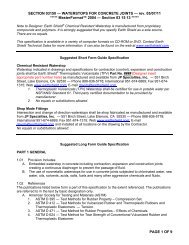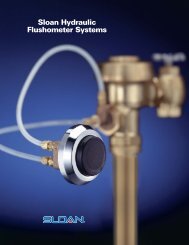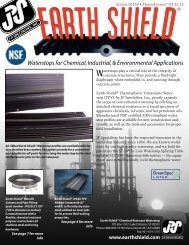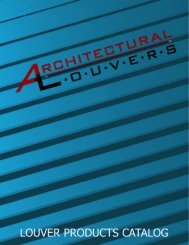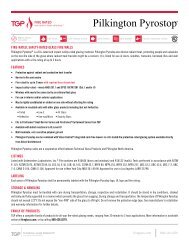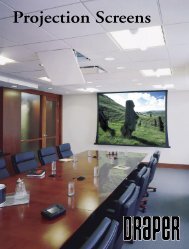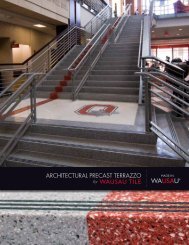National Gypsum Construction Guide
National Gypsum Construction Guide The entire - AECinfo.com
National Gypsum Construction Guide The entire - AECinfo.com
- No tags were found...
You also want an ePaper? Increase the reach of your titles
YUMPU automatically turns print PDFs into web optimized ePapers that Google loves.
STA-SMOOTH PAPER TAPE<br />
TREATMENT METHOD<br />
1. Mix Sta-Smooth Compound<br />
per instructions on<br />
package. Do not<br />
contaminate the compound<br />
with other materials, dirty<br />
water or previous mixes.<br />
Do not retemper.<br />
2. Apply the Sta-Smooth<br />
Compound to the joint by<br />
hand or machine tool. The<br />
drywall paper tape must be<br />
centered over the joint line<br />
and embedded into the soft<br />
compound. Do not overtrowel<br />
to a slick surface.<br />
Leave the surface rough to<br />
provide mechanical keying<br />
of the plaster.<br />
3. Allow the treated joints to<br />
set and dry prior to general<br />
plastering.<br />
KAL-MESH TREATMENT<br />
METHOD<br />
Do not use self-adhering<br />
mesh.<br />
1. Center and secure Kal-<br />
Mesh over all joints and<br />
interior angles with 1/4" or<br />
5/16" staples.<br />
2. Position staples a maximum<br />
of 24" apart as follows:<br />
A. Joints: at alternate edges<br />
for the run from end to end<br />
and directly opposite one<br />
another at either end.<br />
B. Angles: along ceiling<br />
edge only for wall-toceiling<br />
angles. Along one<br />
edge for wall-to-wall<br />
angles.<br />
3. After the first staples are<br />
placed at the end of a joint<br />
or angle, pull unstapled<br />
Kal-Mesh as stapling<br />
proceeds to ensure that<br />
it will lie flat against the<br />
Kal-Kore.<br />
4. Pre-treat all joints and Kal-<br />
Beads with Kal-Kote, Uni-<br />
Kal or X-KALibur Plaster.<br />
Tightly trowel over joint<br />
line in both directions to<br />
prevent voids, feathering<br />
to a maximum width of<br />
about 6".<br />
5. Allow the treated joints to<br />
set prior to general plaster<br />
application.<br />
PLASTERING<br />
Note: Application shall<br />
conform to ASTM C 843.<br />
The same general job<br />
conditions used in good<br />
conventional plastering<br />
practice should be<br />
maintained. However,<br />
because Veneer Plaster<br />
coats are thin, particular<br />
action must be taken to<br />
guard against dryouts<br />
(primarily avoiding direct<br />
exposure to concentrated<br />
sources of heat and drafts.)<br />
Special attention should also<br />
be given to temperature<br />
conditions under which the<br />
system is installed. Both<br />
“in-place” and application<br />
performance of individual<br />
Veneer System components<br />
will be greatly enhanced if<br />
all construction areas and<br />
materials are at a suitable<br />
temperature equilibrium<br />
before, during and after<br />
installations. During cold<br />
weather, maintain a<br />
temperature 55˚F (13˚C) to<br />
70˚F (21˚C) before, during<br />
and after installation of all<br />
system components until<br />
veneer plaster has dried.<br />
MIXING<br />
Equipment: Mixing should be<br />
done with a high-speed<br />
mechanical mixer. A<br />
paddle-type agitator fitted<br />
to a 500-600 RPM heavy<br />
duty, 1/2" electric drill and<br />
a clean, smooth-sided<br />
drum of convenient size<br />
are recommended for<br />
rapid, efficient mixing of all<br />
Kal-Kote Plaster types.<br />
Water Ratios: Use only clean,<br />
fresh water suitable for<br />
human consumption.<br />
Basecoat: 10-12 qts. per 80<br />
lb. bag. Smooth Finish: 18-<br />
20 qts. per 50 lb. bag.<br />
Texture Finish: 11-12 qts.<br />
per 50 lb. bag. Uni-Kal and<br />
X-KALibur: 13-15 qts. per<br />
50 lb. bag.<br />
PROCEDURE<br />
1. Put all but 1 to 2 qts. of the<br />
proper water volume in a<br />
suitable mixing drum.<br />
Note: Starting with an<br />
insufficient amount of<br />
mixing water will seriously<br />
degrade mixing and<br />
application performance.<br />
2. Add plaster and allow to<br />
soak for about 1 minute or<br />
add plaster as mixer is<br />
turning, then mix until<br />
uniformly wetted.<br />
3. Add remaining water and<br />
mix sufficiently to obtain<br />
desired lump-free material<br />
fluidity.<br />
Note:<br />
A. Mixing periods greater<br />
than 5 minutes will not<br />
be required if proper<br />
equipment and procedure<br />
are used.<br />
B. Mix no more than two bags<br />
per batch to avoid mixing<br />
too far in advance of<br />
application.<br />
C. Caution is advised against<br />
mixing more than two<br />
successive batches without<br />
thorough equipment cleanup<br />
to avoid undue set<br />
acceleration.<br />
D. Avoid the practice of<br />
mixing partial bags since<br />
this leads to difficulty in<br />
maintaining uniform<br />
material qualities.<br />
JOB SETTING ADJUSTMENT<br />
1. Basecoat and Finish<br />
Plasters: Small amounts of<br />
commercial retarder or<br />
commercial gypsum type<br />
accelerator may be<br />
cautiously used to adjust<br />
setting time when extreme<br />
conditions demand. When<br />
commercial retarder or<br />
accelerator is used, add to<br />
mixing water directly, or in<br />
previously prepared water<br />
solution form to obtain the<br />
most uniform effect.<br />
2. Never use gauging or<br />
moulding plasters in place<br />
of commercial accelerator<br />
since they can adversely<br />
affect working qualities.<br />
KAL-KOTE APPLICATION<br />
OVER KAL-KORE<br />
Basecoat Over Kal-Kore<br />
1. Tightly scratch material into<br />
previously treated joints<br />
and cornerbeads, then<br />
immediately scratch-in<br />
tightly over the wall and/or<br />
ceiling area.<br />
2. Double back over the area<br />
just troweled with material<br />
from the same batch,<br />
bringing total thickness up<br />
to 1/16" minimum.<br />
3. When plaster has “taken<br />
up,” eliminate excessive<br />
trowel marks and fill all<br />
surface voids and<br />
imperfections to obtain a<br />
reasonably uniform surface.<br />
Do not over-trowel to a<br />
slick surface. Roughen the<br />
unset basecoat plaster<br />
surface with a serrated<br />
darby or lightly wire rake to<br />
provide mechanical keying<br />
09 26 13/NGC<br />
BUYLINE 1100<br />
for the finish plaster when<br />
necessary.<br />
Smooth Finish Over Basecoat<br />
1. Apply only over properly<br />
prepared Kal-Kote basecoat<br />
plaster. Scratch-in tightly,<br />
then double back with<br />
material from the same<br />
batch immediately to<br />
create a uniform coat not<br />
exceeding 1/16" in average<br />
thickness.<br />
2. Remove trowel marks, “cat<br />
faces,” and other major<br />
surface imperfections by<br />
“drawing-up” or “laying<br />
down” the surface with<br />
light trowel pressure when<br />
plaster has stiffened.<br />
Use water sparingly if needed,<br />
but do not over-trowel or<br />
over-water because this<br />
aggravates any normal<br />
tendency for blistering<br />
when working over low<br />
suction bases. Such<br />
blistering will be eliminated<br />
by the final water-troweling<br />
operations.<br />
3. Water-trowel to densify<br />
and polish the surface to<br />
the desired degree when<br />
plaster has set, eliminating<br />
any blistering if present.<br />
Never use a felt “blister<br />
brush” as a substitute for<br />
water troweling!<br />
4. Uni-Kal and X-KALibur<br />
Plaster may be substituted<br />
for Kal-Kote Smooth Finish.<br />
Texture Finish Over Basecoat<br />
1. Apply per (1) under Smooth<br />
Finish.<br />
2. When plaster has stiffened,<br />
float its surface to any<br />
desired finish.<br />
Do not float the soft surface<br />
of plaster which has<br />
already set.<br />
Up to equal parts of clean,<br />
graded silica sand may<br />
be added to Uni-Kal and<br />
X-KALibur to aid texturing.<br />
NATIONAL GYPSUM VENEER PLASTER SYSTEMS<br />
49<br />
09 26 13



